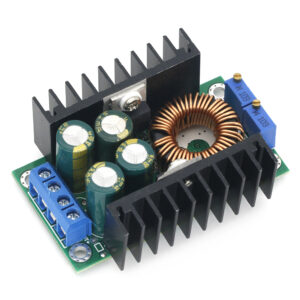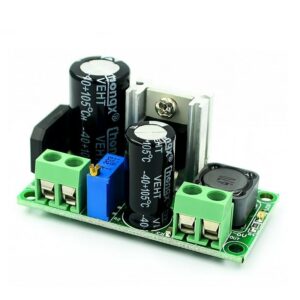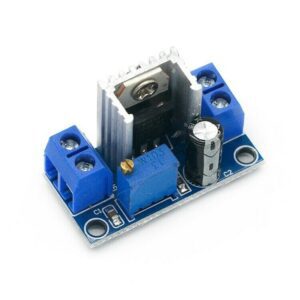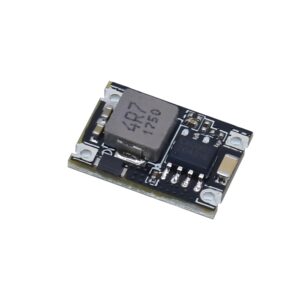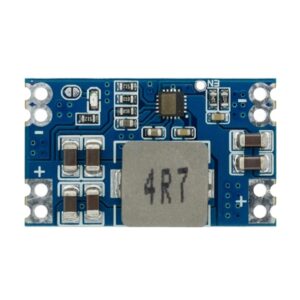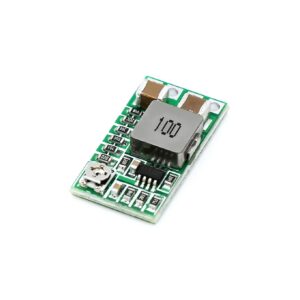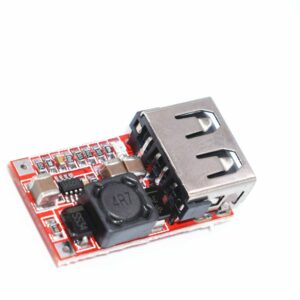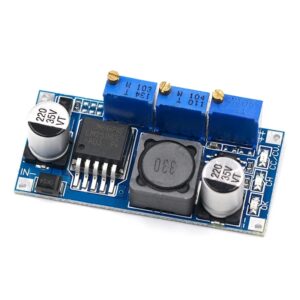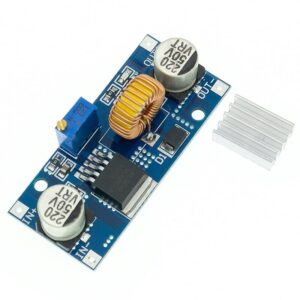Buck Converters
Welcome to our page for Buck Converters!
Good quality selection for variety of options to suit your needs.They are DC to DC Converters that steps down voltage. We also offer dedicated Boost Converters and Buck Boost converters.Explore our catalogue to find the perfect solution for your specific requirements.
Showing all 11 results
- Original price was: £1.90.£1.45Current price is: £1.45. Select options This product has multiple variants. The options may be chosen on the product page
- Original price was: £1.90.£1.45Current price is: £1.45. Select options This product has multiple variants. The options may be chosen on the product page
Showing all 11 results
Buck Converter: Control Voltage Efficiently!
Here at Kunkune, we offer a comprehensive selection to fit your specific needs.
- Wide Input Range: Many of our Buck Converters boast a variable input range, typically from 1V to 30V. This flexibility allows you to handle a variety of power sources.
- Adjustable or Fixed Output: Choose from Buck Converters with adjustable output voltage for ultimate control, or fixed-voltage models for a simple and reliable solution. We recommend fixed-voltage converters for powering devices with specific requirements like 3.3V, 5V, 9V, or 12V.
Practical Uses of Buck Converters in DIY Electronics
- Arduino Projects: Powering an Arduino board with a 12V battery by stepping down the voltage to 5V.
- LED Lighting: Driving LED strips or individual LEDs at a lower, stable voltage. Select the model with adjustable current to extend the life of LED lights.
- Battery-Powered Devices: Extending battery life by efficiently converting voltage for devices like portable speakers or handheld gadgets.
- RC Vehicles: Regulating voltage for motors and electronic components in remote-controlled cars and drones.
- Solar Power Systems: Optimizing power from solar panels to charge batteries or power devices directly.
- Portable Chargers: Creating custom power banks with multiple output voltages for different devices.
- Home Automation: Powering sensors and microcontrollers in smart home setups from a common higher voltage source.
Benefits of Buck Converters
Advantages:
- Efficiency: High efficiency reduces energy loss and heat generation, making them ideal for battery-powered devices.
- Size Reduction: Smaller components and higher efficiency allow for more compact designs.
- Cost-Effectiveness: Lower energy consumption and reduced need for cooling components lead to cost savings.
Comparative Overview:
- Buck Converters: Step down voltage efficiently, ideal for applications requiring lower voltage from a higher input.
- Boost Converters: Step up voltage from a lower level to a higher level, used when a higher voltage is needed.
- Buck-Boost Converters: Can step up or step down voltage, providing versatility for varying input and output requirements.
List of our Buck Converters
- 300W 9A Step Down Buck Converter 5-40V to 1.2-35V Power Supply Module
- Output: Adjustable
- Description: A high-power buck converter with a broad input range and adjustable output voltage, perfect for demanding applications.
- Mini 360 Adjustable Step Down Power Supply Buck Converter
- Output: Adjustable
- Description: Compact and efficient, this mini buck converter is ideal for projects with space constraints.
- LM2596 Buck Converter Constant Current and Voltage Adjustable
- Output: Adjustable
- Description: Features both constant current and voltage adjustments, making it versatile for various power supply needs.
- LM2596HV Voltage Regulator Step Down Buck Converter 4.5-50V to 3-35V Adjustable
- Output: Adjustable
- Description: High-voltage input capability with a wide adjustable output range, suitable for many applications.
- LM317 Buck Step Down Adjustable Voltage Converter
- Output: Adjustable
- Description: Reliable and easy-to-use, this converter is perfect for precise voltage control in various electronics projects.
- 5-30V to 3.3-5V Fixed Mini Buck Converter Step Down Module Airplane
- Output: Fixed (3.3V or 5V)
- Description: Designed for stable output in aviation applications, this mini converter offers a fixed voltage output.
- Mini560 5V-20V to 3.3V 5V 9V 12V 5A Step Down Buck Converter Power Supply
- Output: Fixed (3.3V, 5V, 9V, 12V)
- Description: Versatile with multiple fixed output options, this converter supports various electronic projects.
- Small Step Down Adjustable or Fixed Buck Converter
- Output: Adjustable or Fixed
- Description: Offers flexibility with both adjustable and fixed output settings, suitable for a range of power supply needs.
- USB Step Down Buck Converter 6-24V to 5V
- Output: Fixed (5V)
- Description: Perfect for USB-powered devices, this converter steps down a wide input range to a stable 5V output.
- Voltage and Current Adjustable Buck Converter
- Output: Adjustable V, A
- Description: This converter allows precise control of both voltage and current, ideal for customized power supply solutions.
What are Buck Converters?
Buck converters, also known as step-down converters, are essential DC-to-DC converters designed to efficiently step down voltage while maintaining the required current levels, often used in various electronic applications.
These converters play a crucial role in regulating the power supply to electronic devices by converting a higher voltage input into a lower, more usable output. By reducing the voltage, buck converters help devices operate efficiently without risking damage from excessive power levels.
One of the key advantages of buck converters is their ability to provide a stable power supply to sensitive electronic components, ensuring consistent performance. This makes them ideal for applications such as mobile devices, computers, and IoT devices where maintaining a specific voltage level is essential for proper functioning.
How do Buck Converters Work?
Buck converters operate on principles of switching, utilising components such as inductors, capacitors, transistors, and diodes to efficiently convert higher input voltages into stable, lower output voltages.
What are the Components of a Buck Converter?
A buck converter circuit typically comprises key components such as an inductor, a capacitor, a transistor (often a FET), and a diode, each playing a crucial role in the voltage conversion process.
Starting with the inductor, this component stores energy in its magnetic field during the transistor’s on cycle. As the transistor switches off, the inductor releases this stored energy, acting as an energy source for the circuit.
The capacitor, on the other hand, helps in smooth regulation of the output voltage by filtering out any ripples.
The transistor, typically a FET (Field Effect Transistor), controls the energy flow by switching on and off rapidly, regulating the voltage across the circuit efficiently.
The diode ensures that the current flows unidirectionally, preventing any reverse flow that may damage the system.
What are the Advantages of Using Buck Converters?
Buck converters offer several advantages, including high efficiency, cost-effectiveness, compact size, and ease of control, making them ideal for various power supply applications.
High Efficiency
One of the primary advantages of buck converters is their high efficiency in converting DC power, making them suitable for power supplies with stringent power requirements.
This efficiency stems from the converter’s ability to step down voltage while maintaining high efficiency levels, resulting in minimal power loss and improved overall performance in the power supply system. By reducing the input voltage to a lower, more usable level, buck converters help optimise energy usage, making them ideal for applications where maximising power efficiency is crucial.
Cost-effective
- Step-down converters are cost-effective solutions for various applications, offering an affordable means to meet specific power requirements without compromising performance.
- These efficient power devices are widely used in industries ranging from automotive to telecommunications due to their ability to efficiently step down voltage levels, resulting in reduced power loss and minimised heat dissipation.
- The affordability of step-down converters also makes them popular in consumer electronics, where cost considerations play a crucial role in product design. Their compact size and high efficiency further enhance their appeal for applications where space is limited, such as portable electronic gadgets.
Small Size
The small size of buck converters, available in both leaded and unleaded packages, allows for easy integration into compact electronic devices and systems.
This compact nature makes buck converters highly desirable in various space-constrained applications like mobile phones, laptops, and automotive systems. The availability of different package types further enhances their versatility, with options including DIP, SOIC, QFN, and BGA. Leaded packages are commonly used for through-hole mounting, offering robust mechanical support, while unleaded packages cater to surface-mount applications, saving valuable board space.
Easy to Control
Buck converters are known for their ease of control, often utilising a controller to adjust the duty cycle and maintain precise output voltage.
The controller in a buck converter plays a crucial role in regulating the output voltage. It continuously monitors the feedback signals and adjusts the duty cycle of the switching transistor accordingly. By modulating the on/off time of the transistor, the controller ensures that the output voltage remains stable despite variations in input voltage or load conditions. This dynamic adjustment is what makes buck converters efficient in a wide range of operating conditions.
What are the Applications of Buck Converters?
Buck converters are versatile power devices used in a myriad of applications, including voltage regulation, power supplies, and battery charging, due to their efficiency and reliability.
Voltage Regulation
- Step-down converters are commonly used for voltage regulation, ensuring a stable output voltage through precise control circuitry.
- By stepping down the input voltage to generate a lower output voltage, step-down converters play a crucial role in various applications such as power supplies, battery chargers, and LED drivers. The efficiency of step-down converters lies in their ability to regulate voltage by adjusting the duty cycle of the switching signal through the control circuitry.
- This mechanism helps in maintaining a consistent output voltage, compensating for fluctuations in the input voltage and ensuring the proper functioning of connected electronic devices. The compact design and high efficiency make step-down converters a popular choice for voltage regulation in diverse electronic systems.
Power Supplies
In power supplies, step-down converters efficiently transform higher input voltages into lower, stable output voltages required by various electronic devices.
Step-down converters play a crucial role in managing power distribution, especially in portable devices where space and energy efficiency are paramount. By utilising a switching regulator to control the output voltage, these converters ensure that electronic components receive the correct power levels. Due to their high efficiency, they help minimise energy loss, making them ideal for battery-powered devices. With the ability to step down voltage levels while maintaining stability, step-down converters are versatile components widely used in modern electronics.
Battery Charging
Buck converters are crucial in battery charging applications, providing the necessary power conversion to safely and efficiently charge batteries in various devices.
These innovative devices play a pivotal role in transforming higher voltage supplies to lower levels, which are ideal for charging batteries without overheating or overloading them. By regulating the output voltage with precision, buck converters prevent damage to sensitive electronics in devices such as smartphones, laptops, and electric vehicles. The efficiency of power transfer achieved by buck converters also contributes significantly to prolonging the battery life of these essential gadgets, ensuring that they remain operational for extended periods of time.
What are the Different Types of Buck Converters?
There are several types of buck converters, including synchronous and non-synchronous buck converters, as well as buck-boost converters, each with unique characteristics and applications.
Synchronous Buck Converter
Synchronous step-down converters improve efficiency by using integrated FETs (Field-Effect Transistors) instead of diodes for rectification.
Integrated FETs, through their synchronous operation, provide a more direct path for current flow, minimising power losses in the conversion process.
When the FETs are switched on, they conduct current more efficiently compared to traditional diodes, allowing for reduced voltage drops and heat dissipation.
This synchronous switching mechanism enables the converter to regulate output voltage with higher precision and speed, enhancing overall performance and reliability.
Non-synchronous Buck Converter
Non-synchronous buck converters use a diode for rectification and are simpler in design compared to their synchronous counterparts, but they may be less efficient.
One of the key characteristics of non-synchronous buck converters is their straightforward design, which results in cost-effective manufacturing processes. The diode in these converters plays a crucial role in conducting the current in only one direction, allowing for efficient energy transfer. This simple design reduces the number of components required, making the system more reliable and easier to troubleshoot.
The switching transistor in a non-synchronous buck converter controls the flow of current through the circuit. It regulates the voltage output by switching rapidly on and off, enabling efficient power conversion. While non-synchronous converters may have lower efficiency levels than synchronous ones due to the voltage drop across the diode, their simplicity makes them popular in various applications.
Buck-boost Converter
- Step-down/step-up converters are versatile devices capable of both stepping down and stepping up voltage, making them suitable for applications with variable input and output requirements.
- These converters are essential components in systems where the input voltage may fluctuate or when the output voltage needs to be different from the input voltage. With their ability to handle a wide range of voltage levels, they find use in industries such as automotive, renewable energy, telecommunications, and portable electronic devices.
- Step-down/step-up converters are known for their efficiency in power management by adjusting the output voltage to match the required specifications. This feature makes them ideal for battery-powered devices that need a stable voltage supply to operate effectively.
What Factors Should be Considered when Choosing a Buck Converter?
When selecting a step-down converter, several factors must be considered, including input and output voltage requirements, current capacity, efficiency, and the size and form factor of the converter.
Input and Output Voltage Requirements
The input and output voltage requirements are critical when choosing a buck converter, as they determine the converter’s ability to regulate voltage effectively.
Ensuring that the input voltage falls within the acceptable range of the buck converter is essential for its optimal performance. If the input voltage exceeds the converter’s specifications, it could result in inefficient operation or even damage to the converter.
Similarly, the output voltage must match the requirements of the load to maintain stable and reliable operation. Matching the input and output voltages ensures that the buck converter can provide the necessary level of voltage regulation to power the connected device.
Current Capacity
The current capacity of a buck converter must match the load requirements to ensure reliable operation and prevent damage to power devices.
When selecting the appropriate current capacity for a buck converter, it’s crucial to consider the maximum current that the load will draw. This value typically indicates the peak power demand and helps in determining the minimum current rating needed for the converter. Understanding the characteristics of the power devices being used is essential. Different devices have varying tolerances and operating parameters that influence the current capacity required for stable performance.
Efficiency
Efficiency is a key factor in choosing a step-down converter, as higher efficiency reduces power loss and aids in thermal management for power supplies.
Highly efficient step-down converters play a crucial role in various electronic devices, from laptops to mobile phones, ensuring optimal performance while keeping energy consumption at bay. The power loss in a system can significantly decrease with the incorporation of high-efficiency step-down converters, thereby promoting longer battery life and reducing heat generation.
When thermal management is enhanced through the use of efficient step-down converters, the overall reliability and longevity of the power supply system are improved, making it a preferred choice for demanding applications.
Size and Form Factor
The size and form factor of a buck converter, including whether it comes in leaded or nonleaded packages, can significantly impact its integration into electronic systems.
Considering the physical dimensions of a buck converter is crucial, as it determines how easily it can fit within the constraints of a given electronic setup. The choice between leaded and nonleaded packages further adds complexity to this decision-making process.
An advantage of leaded packages is their robustness and ease of soldering, making them suitable for applications where mechanical stress is a concern. On the other hand, nonleaded packages offer space-saving benefits, ideal for compact designs that prioritize efficiency and thermal management.

